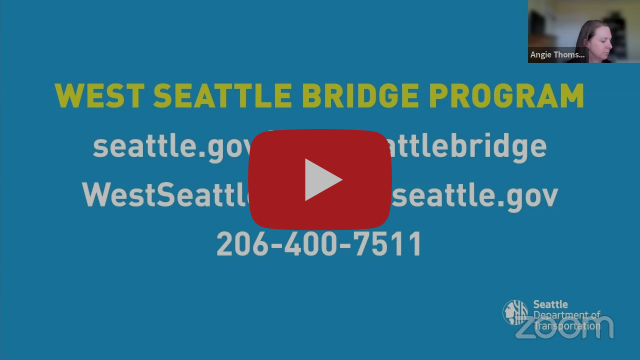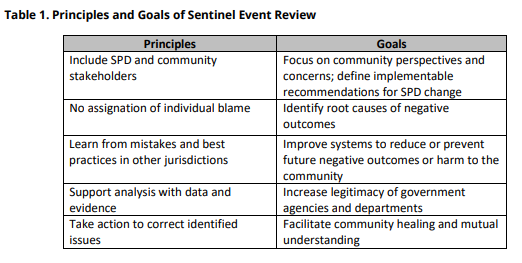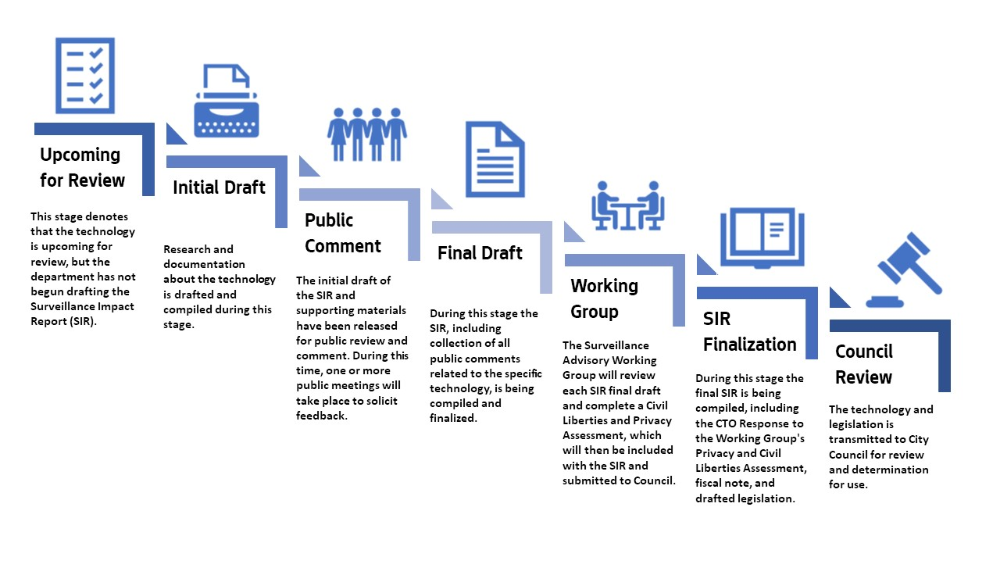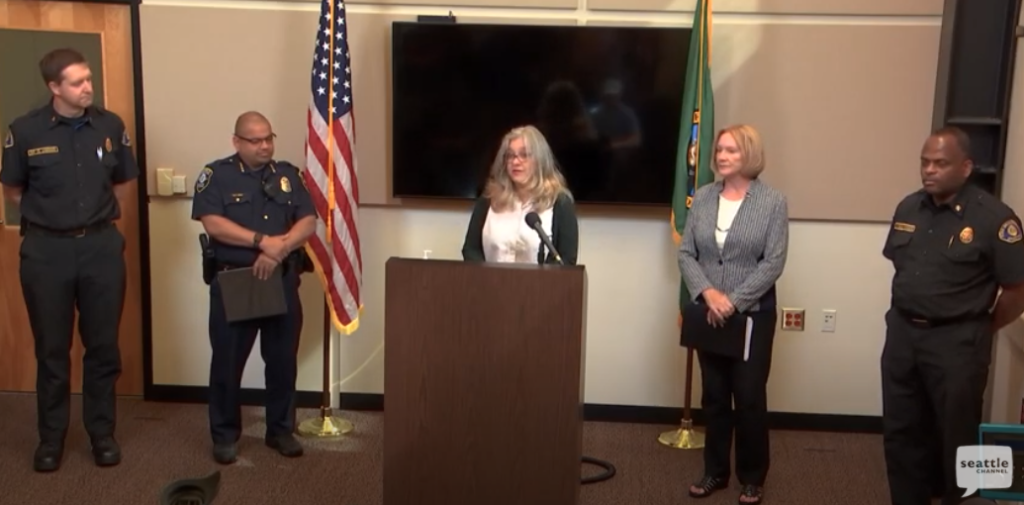West Seattle Bridge: Public Meeting / $12 Million More in Federal Funding; $10.4M in Community Safety Awards; Office of the Inspector General Sentinel Event Review; Council Approves Creation of Economic Forecasting Office; Designating Facial Recognition Technology as Surveillance Technology; Triage One Announced Today
West Seattle Bridge: Public Meeting/$12 Million More in Federal Funding
On Tuesday, SDOT hosted a virtual public meeting about the West Seattle Bridge repair. More than 250 community members attended. You can watch the meeting on YouTube. In coming weeks SDOT will post subtitles in English, Spanish, Korean, Vietnamese, Chinese, Khmer, Somali, and Oromo on the West Seattle Bridge Program page. They’ll also post a translated meeting summary, and the Q&A, as well as the translated power point presentation. Deputy Mayor Moseley announced that the WSDOT has approved $12 million in additional federal funds for the bridge repair, from funds that that WSDOT administers. This brings the total of federal funds dedicated to the repair to $38 million.
$10.4M in Community Safety Awards Announced
Throughout 2020, the calls from community to invest in alternatives to policing were consistent, loud and clear. Seattle City Council answered that call by appropriating $16 million to invest in community-led organizations that are creating community safety on the ground every day in Seattle. Last year, the Human Services Department moved quickly to award $4 million to the Seattle Community Safety Initiative, which is building community safety hubs and wraparound services in three Seattle neighborhoods – including West Seattle – under the leadership of Community Passageways. This week, the Human Services Department (HSD) announced $10.4 million awarded to community-led organizations that are building safety in our neighborhoods from the ground up. This new investment will bring together a cohort of organizations dedicated to reimagining how community safety can be achieved in Seattle, and gives them the resources they need to lead the way in creating safety in our City. Services and strategies include:
- Activating neighborhood-based strategies to reduce crime rates at hotspot
- De-escalation support in response to shots fired
- Re-entry services
- Case management
- Community awareness about disproportionality in criminal legal services
- Family support to prevent youth from entering the criminal legal system
- Supports to address family and gender-based violence
Representatives from HSD will attend my August 10th Public Safety & Human Services committee meeting to make a presentation on the grant awards. You can sign up to receive an agenda for that meeting.
Office of the Inspector General Sentinel Event Review
Yesterday the Office of the Inspector General (OIG) released a Sentinel Event Review of Police Response to 2020 Protests in Seattle, Wave 1: Downtown Protests May 29-June 1. A sentinel event is defined as a significant negative outcome, such as a death or serious injury, that acts as a signal that problems within a system exist and may lead to similar bad results if the system is not examined to find root causes and proper remedies. Industries like airlines and health care providers have developed and used “sentinel event review” processes to thoroughly examine these types of incidents, identify what caused them, and use those lessons to prevent them in the future. AS the OIG website notes, Sentinel Event Review (SER) “aims to identify the causes and contributing factors to these incidents with the goal of prevention.” The principles and goals of these reviews are:
The review includes 54 recommendations, from five incidents, and events preceding those incidents:
The Office of the Inspector General, and community members who participated in the Sentinel Review as panel members, will provide a briefing to the Public Safety and Human Services Committee on Tuesday, July 27th.
Council Approves Creation of Economic Forecasting Office
On Monday the Council voted to approve the creation of an independent Economic and Revenue Forecasts’ Office. This action brings the City in line with the best practices of State and County government. The Central Staff memo notes, “Similar to functions of the King County Office of Economic and Financial Analysis and the Washington State Economic and Revenue Forecast Council, the ERFO would provide independent forecasts and economic analyses.” My thanks to Council President González for developing this proposal to insure that, in future years, the Council is on a level playing field with the Mayor in making budget proposals. The timing and manner in which forecasts are shared with the Council should not be used as a strategic advantage for the executive. Doing so only creates conflict. The memo notes that changes in forecasted revenues are at times presented to the Council simultaneously with new Executive branch spending proposals. The memo notes “Any difference between when data is first known and publicly communicated represents an opportunity to form a strategy and communicate policy proposals for using new resources.” This is true for any potential reductions as well.
Designating Facial Recognition Technology as Surveillance Technology
At Monday’s Full Council meeting we will be voting on a Clerk File – sponsored by myself and Councilmember Pedersen – that will ensure facial recognition technology is considered surveillance technology and therefore subject to the rigors of the City’s Surveillance Ordinance. You can read a description of how that ordinance works here. This image breaks down the basic steps in a review process for any technology considered to be “surveillance technology.”
During a recent Office of Professional Accountability (OPA) investigation (2020OPA-0731), the Director concluded that an officer’s use of facial recognition technology was not in violation to the City’s Surveillance Ordinance. I disagreed with this analysis and believe that facial recognition technology is currently fully within the jurisdiction and purview of the Surveillance ordinance, meaning that use of this technology is currently prohibited unless reviewed and approved as described in the graphic above. However, in order to eliminate any confusion in the future whether facial recognition technology is covered by the Surveillance Ordinance, Councilmember Pedersen and I brought forward this Clerk File to settle the question.
In November of 2020, Chief Diaz wrote: “SPD does not use Clearview AI [a facial recognition technology] and has no intention of using Clearview AI. As Chief, I am committed to upholding the tenets of the Surveillance Ordinance and the civil liberties of our residents. Clearview AI’s business product is at odds with those two central priorities.” Further, on my request SPD, sent out a department wide communication reminding everyone in the SPD about the policy. It makes clear that one cannot use personal technology as a means to bypass City policies and included the policies:
“SMC Chapter 14.18 prohibits the use of personal technology, administrative privileges, or any other means to bypass City processes on acquisition and use of surveillance technology.
Please review SMC Chapter 14.18 definitions of surveillance technology and the Chapter requirements concerning the acquisition of any new surveillance technology. The full SMC can be found here: https://library.municode.com/wa/seattle/codes/municipal_code?nodeId=TIT14HURI_CH14.18ACUSSUTE
SMC 14.18.020 requires Seattle City Council approval for acquisition of surveillance technologies by all City employees prior to use.”
The Chief, at a later date, publicly indicated that it is a “gray area” saying “It is not Chief Diaz’s position that Seattle’s Surveillance Ordinance, as presently codified, covers the use of facial recognition software.” The Clerk File before the Council on Monday will ensure that in the future the Surveillance Ordinance does indeed cover the use of facial recognition technologies and will be subject to the review process outlined above.
Specialized Triage One Response Model Announced Today
Throughout 2020, the calls from community to invest in alternatives to policing were consistent, loud and clear. We know that not every call to 911 requires an armed response. A new specialized triage response model has been proposed. It is both creative thinking and a data-informed innovation, providing a qualified response to folks who require assistance but do not represent a threat.
I am increasingly hearing from constituents who are asking for exactly this kind of option, to help their family, friends, and neighbors. The analysis on the city’s 911 calls shows that a proposed Triage One system could respond to about 8,000 calls a year. An analysis of Seattle’s 911 calls will be presented to my Public Safety and Human Services committee next week. The more calls we take out of the 911 response system, the better response times will improve for police officers to respond to 911 calls that only they can take. The Mayor enacted an Executive Order last year, and the City Council passed a similar Statement of Legislative Intent. The Triage One proposal is one small element expected out of that much broader analysis that is scheduled to be heard on Tuesday.
911 call takers have been called the ‘gatekeepers for the entire criminal justice system.’ It’s past time that we provide better tools to our dispatchers so that the right resources can be deployed.
I have proposed funding in the second quarter supplemental budget for a new protocol dispatch system so dispatchers recently transferred by the Council from SPD to the Community Safety Communication Center can better deploy these new specialized triage response responders. The protocol system will also allow for better data analysis to allow for the continued evolution of resource deployment.
Posted: July 23rd, 2021 under Councilmember Herbold, Human Services, Office of Police Accountability, Police Department, Public Health, Transportation
Tags: Bridge, District 1, SDOT, transit, West Seattle, West Seattle Bridge






